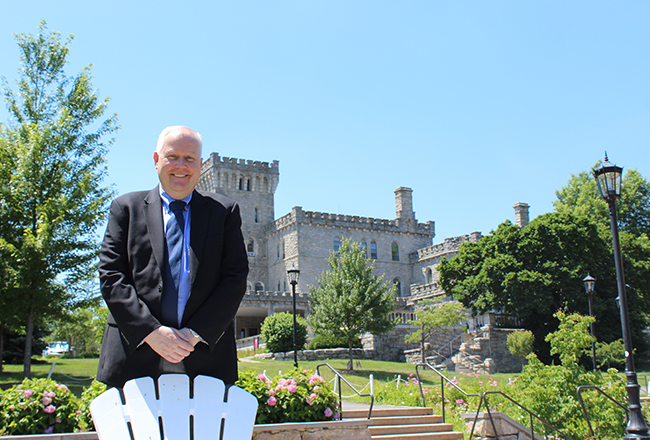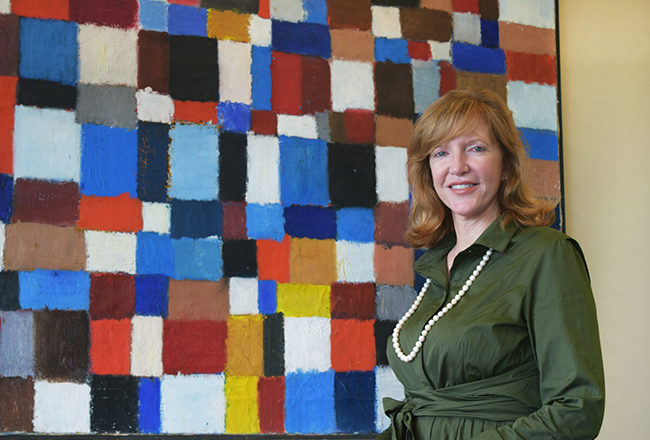
Students arriving at Manhattanville College this fall will be welcomed by some new seating options: Adirondack chairs placed in circles throughout campus.
The chairs are a subtle sign of what”™s to come from the Purchase college”™s Center for Design Thinking. By fall 2019, the college plans to launch the center, which will be dedicated to immersing students in a results-oriented, problem-solving approach. Manhattanville is partnering with IDEO, an international design and consulting firm, on the center.
As President Michael Geisler explained, the chairs are part of a training exercise in design thinking. The chairs are one of several solutions the school’s design thinking trainees are testing for the center”™s launch.
“Most of our students have to work to some degree,” Geisler said. “So how can we create a campus culture and curriculum that allows them to do their work, but still provides them with a satisfying academic and community experience while they”™re students?”
The answers to that question can be both big picture, and quite small, such as simply providing Adirondack chairs for people to use as a common workspace.
Geisler, a former professor of German at Middlebury College in Vermont, was inaugurated as the school”™s 13th president in fall 2016. Business Journal reporter Ryan Deffenbaugh met with him in July to discuss design thinking, the challenges of his first two years on the job and his belief in Westchester County”™s future.
So what exactly is design thinking?
“I would say design thinking emerged in reaction to the realization that even teams of experts will not always come up with a customer-friendly solution, as long as they all come from the same discipline.
Design thinking recognizes that people coming from different disciplinary backgrounds ”” scientists, social sciences, the arts and humanities ”” have both different ways of framing the problems, which is important, but also different ways of coming up with solutions. So you come up with very different solutions to problems.”
How does it fit with a liberal arts education?
“In a sense, I always feel design thinking is industry”™s recognition of the value of a liberal arts education. Because, that”™s what a liberal arts education, at least at small liberal arts colleges, has always done. It”™s logic-based, goal-oriented. It puts small communities of students and learners together in a space where creativity is enabled and encouraged. It makes them all focused on a common goal.
What it does that we don”™t do as well, is it adds a pragmatic goal-oriented approach to learning.
Contrary to what many people think, design thinking is really goal-oriented. They want a result at the end of the process. A tangible result. Not just to say you came up with something, but it actually has to have a market value.
So students don”™t just have so many courses in biology, this many courses in history, this many courses in French. They may still do that. But they, at the same time, learn in their four years here to look at a project where they have to deliver a result within a predicable period of time.”
To switch tracks, what draws you personally to higher education?
“The short version is insatiable curiosity. I studied German and English and American literature. I have a master”™s in both, before I did my Ph.D. in German. Not primarily because I”™m so fascinated by literature, although I like literature, but more because I”™m interested in narratives and how different narratives, particularly different cultural narratives, shape the way we look at the world.
In many other career preparations, you have to very early on specialize in a particular area. I am, by my nature, interdisciplinary.
If you really want to understand what makes humans tick, you need to go across different disciplines. You can”™t just approach from one particular discipline. And that needs a certain freedom of thought.”
That”™s an interesting lead-in to a question about growing political-cultural divides in the country, which have lately played out especially on college campuses. How do you balance different beliefs on a campus during a polarized time?
“With great difficulty. That”™s going to be one of the greatest challenges to universities and colleges. To faculty, staff, administration and boards, not just me. I would be the point person on that, but it”™s a whole college.
To put it in perspective for a moment, it is a grave challenge for me as president. But, in a sense, I”™m much more worried about the challenge this provides for us as a culture, a society. The problems that colleges have are laughable compared to the problems we face as a society.
I mean that not with any kind of nod to one particular political party or the other, but we need to return to a bipartisan, consensual political culture. Consensual does not mean you sweep the conflicts under the carpet, but that you have spaces where conflictual positions and visions can be articulated safely without being attacked, other than an attack on the position. We”™ve lost all of that.”
How do universities and colleges provide that type of space, where you can share views without fear of attack?
“I”™ve consistently said that every solidly researched and fact-based position needs to be able to be heard. I”™m using a slightly different wording than your question. Not every view needs to be discussed at a college, but every position that is based on research and based on fact. Our job is not to provide a political platform for people to scream at each other. Our job is to provide thinking space and listening space, and speaking space, for people to articulate well-researched positions based on fairly presented facts.
Academic freedom is not your freedom to tell one particular group that because of who they are, they can be disrespected. And I don”™t care whether that comes from the left or the right, I apply that equally to both sides.
The good news is that we have kept a relatively civil discourse. We have not been always successful. Of course, things happen, but it hasn”™t led to a Berkeley or even Middlebury type war of ideologies. We”™ve had a certain modicum of respect that people on both sides of the political aisle have so far observed and I would like to keep that.”
This fall will be the start of your third year as president here, what have you learned in that time?
“(The Excelsior Scholarship, the state program to fully cover the cost of tuition at public colleges to qualifying families) was a huge challenge, because it was a direct attack on private colleges and universities. Suddenly someone feels that an entire industry that provides somewhere between 400 and 500 thousand jobs in New York State is dispensable. That”™s a little difficult to deal with in your first year.
Our enrollments are stable. We”™ve just completed our seventh consecutive year of balanced budgets or budgets with small surplus. We have a small, but growing, endowment.
One of the things I found I had to do when I came here is to talk people out of the survivalist mode. When I came, people were always looking year to year, because in the late 1980s, early 1990s, we almost went under.
But we are not there anymore. For the first time in decades, we can say this is not about whether we will be here five years from now. But how do we position Manhattanville to become a research hub and an intellectual crucible for life and learning in Westchester County, and eventually the tristate area? And by the time I leave, maybe nationally. We”™ve been there before. We were one of the best-known colleges in the nation in the ”™60s, and there is no reason why we can”™t within a decade or so be in the same position.
We are in an ideal location. I came to Westchester County before I got this job. I was going to retire. I bought a condo in White Plains because I think Westchester is one of the communities with the most promise in America.
It”™s so well connected to New York on the one side, Connecticut on the other side, relatively close to Boston even. I think if we play our cards right, though this is beyond an individual college, we could become one of the economic and intellectual powerhouses of the nation.”
To end on a more lighthearted question, what are some of the things you”™ve come to enjoy so far in Westchester and nearby?
“Untermyer Gardens in Yonkers. They”™re still working on it, but even now it is fantastic. We went, my wife and daughter last year, and loved it.
We”™ve been to Teatown Lake Reservation, and I realized I can walk around a lake the same way I did in Vermont, but again in Westchester County. There”™s lots of hiking and easy trails.
I love the sculpture gardens at PepsiCo. It”™s one of the most amazing sculpture gardens I”™ve seen.
I love downtown Rye, particularly Patisserie Salzburg, that”™s where my German background comes through.
For restaurants, and I own no stock in any of these, I just love them, there”™s Coriander, a great Indian restaurant on Mamaroneck Avenue in White Plains, Gus”™ Franklin Park Restaurant in Harrison, the Rye Roadhouse. And I finally found the perfect bagels.”
After much searching?
“Yes. I”™ve tried every bagel store within a 10-mile radius, I think. One of the things you miss coming from Germany to the U.S. is bread. Germans make the best baked goods in the world, I am convinced of that. But the Bagel Emporium in Armonk, where I get my bagels every Sunday at 6 a.m. or 6:30, has the best bagels that I”™ve found.”
Note: This interview was edited and condensed for clarity.






















